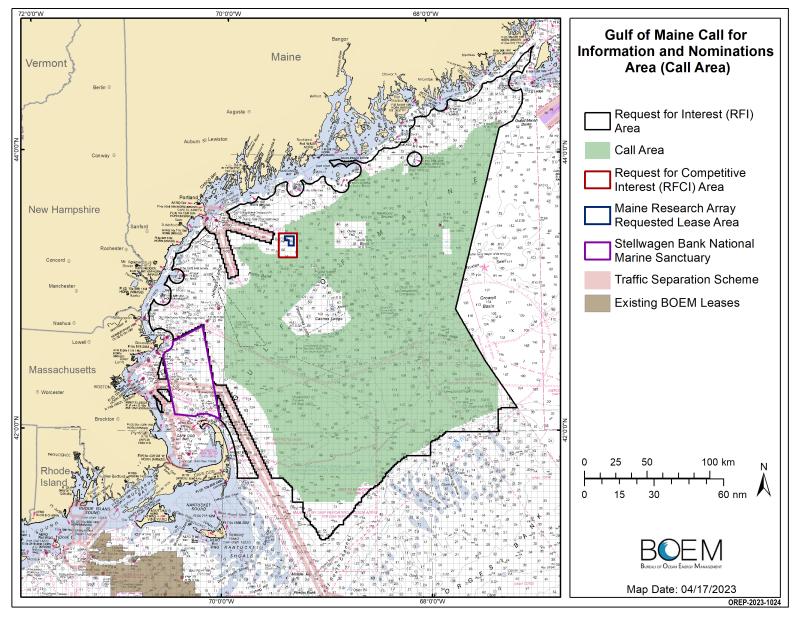The Bureau of Offshore Energy Management will assess offshore wind energy developers’ interest in 9.8 million acres in the Gulf of Maine with a public comment period starting April 26.
The final “call for information” announced Tuesday reduces the original 13.7 million-acre area outlined by BOEM in August 2022 by nearly 30 percent, according to the agency.
The removals include about 160,000 acres taken out of future consideration to avoid Georges Bank. BOEM officials say they are continuing to use a spatial analytical tool, called an ecosystem-wide suitability model developed along with National Centers for Coastal Ocean Science, to identify other areas of potential conflict.
Public comments on the final call area will be open for 45 days through June 12, starting with its publication in the Federal Register Wednesday. Based on comments to the agency for the first draft area, BOEM is looking specifically for more public input about potential effects of wind power development on:
- Lobster Management Area I.
- Platts Bank.
- The Atlantic Large Whale Take Reduction Plan Restricted Areas.
- An area of Georges Bank immediately adjacent along the southern boundary of the call area.
“The feedback that we have received prior to this announcement has been extremely valuable in informing the process and understanding the unique dynamics that the Gulf of Maine presents,” said BOEM project coordinator Zach Jylkka in announcing the final map.
BOEM will host a third Gulf of Maine Intergovernmental Renewable Energy Task Force meeting May 10-11, in Bangor, Maine. The public gathering of representatives from state and federal agencies will update BOEM’s commercial and research offshore wind energy planning activities and to discuss next steps for the Gulf of Maine. The public is encouraged to attend this meeting.
Additional information can be found on BOEM's webpage: https://www.boem.gov/Gulf-of-Maine/
With plans for intensive offshore wind development well underway off southern New England, BOEM is enlisting the National Academies of Sciences, Engineering and Medicine to look at potential environmental and oceanographic effects of turbine construction and operations.
A new National Academies committee first met Tuesday for an introductory briefing on their task, titled “Evaluation of Hydrodynamic Modeling and Implications for Offshore Wind Development: Nantucket Shoals.”
Requested by BOEM, the committee of scientists is to examines how turbine place could affect ocean waves, currents and wind. The questions include how the physical location of turbine towers and dynamic motion of turbine blades might alter currents and produce so-called wind wake downwind of operating turbines.
One high-profile issue is how planned New England wind projects – eight in all – might affect the highly endangered North Atlantic right whale population, now estimated to number only around 340 animals.
In May 2022 a group of 14 experts with the National Oceanic and Atmospheric Administration recommended BOEM investigate potential effects on whales that feed in the Nantucket Shoals region. They suggested an addition buffer area of 20 kilometers (10.8 nautical miles) be considered to mitigate impacts on the whale population.




